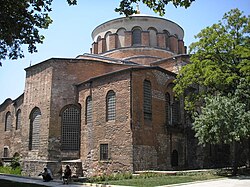Hagia Irene
| Hagia Irene | |
|---|---|
 |
|
| Basic information | |
| Location | Istanbul, Turkey |
| Geographic coordinates | 41°0′35″N 28°58′52″E / 41.00972°N 28.98111°ECoordinates: 41°0′35″N 28°58′52″E / 41.00972°N 28.98111°E |
| Affiliation | Eastern Orthodox |
| Status | Museum |
| Architectural description | |
| Architect(s) | Unknown |
| Architectural type | Church |
| Architectural style | Byzantine |
| Groundbreaking | 4th century |
| Materials | Brick, Stone |
Hagia Irene or Hagia Eirene (Ancient Greek: Ἁγία Εἰρήνη, Byzantine Greek pronunciation: [aˈʝia iˈrini], "Holy Peace", Turkish: Aya İrini), sometimes known also as Saint Irene, is an Greek Eastern Orthodox church located in the outer courtyard of Topkapı Palace in Istanbul, Turkey. The Hagia Irene today operates as a museum and concert hall.
The church was dedicated by Constantine to the peace of God, and is one of the three shrines which the Emperor devoted to God's attributes, together with Hagia Sophia (Wisdom) and Hagia Dynamis (Power).
The building reputedly stands on the site of a pre-Christian temple. It ranks, in fact, as the first church built in Constantinople. Roman emperor Constantine I commissioned the first Hagia Irene [Reference?] church in the 4th century. It served as the church of the Patriarchate before Hagia Sophia was completed in 360. From May to July 381 the First Council of Constantinople took place in the church. It was burned down during the Nika revolt in 532. Emperor Justinian I had the church restored in 548.
Heavily damaged by an earthquake in the 8th century, it dates in its present form largely from the repairs made at that time. The Emperor Constantine V ordered the restorations and had its interior decorated with mosaics and frescoes. Hagia Irene is the only example of a Byzantine church in the city which retains its original atrium. A great cross in the half-dome above the main narthex, where the image of the or Theotokos was usually placed in Byzantine tradition, is a unique vestige of the Iconoclastic art; presumably it replaced earlier decoration. The church was enlarged during the 11th and 12th centuries.
...
Wikipedia
